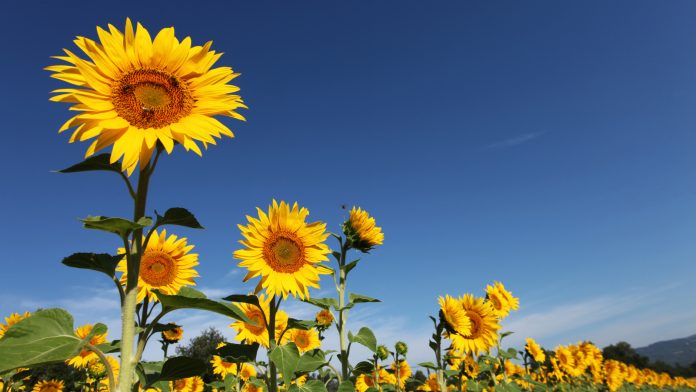A research team from the University of British Columbia (UBC) has discovered that the ultraviolet (UV) colours of sunflowers attracts pollinators, aiding in pollination, and helping the plant regulate water loss.
Scientists investigated sunflower pollination
The dense collection of yellow petals of a sunflower (or an ‘inflorescence’) is a typical sight, but it is what is invisible to the human eye that is important: a UV bullseye pattern is emitted from the flower, which is invisible to humans but not to most insects, such as bees.
The bullseye patterns have been proven to improve the attractiveness of flowers to pollinators by increasing their visibility, and therefore increasing pollination. UBC researchers have found that the same molecules that produce UV patterns in sunflowers are the same molecules involved in helping the plant respond to stresses, such as drought or extreme temperatures.
“Unexpectedly, we noticed that sunflowers growing in drier climates had flowers with larger UV bullseyes and found that those flowers are able to retain water more efficiently. This suggests that these larger UV bullseyes help plants adapt to these drier environments,” commented Dr Marco Todesco, lead author, and a research associate at UBC’s biodiversity research centre and department of botany.
UBC researchers conducted a study to explore this topic
Todesco and his team grew almost 2,000 wild sunflowers of two different species at the university in 2016 and 2019. In each experiment they measured the sunflowers’ UV patterns and analysed the plants’ genomes.
These observations revealed that wild sunflowers from different parts of North America had UV bullseyes that were very different in terms of size; in some, the bullseye was a thin ring, while in others it covered the whole flower. Larger bullseyes were visited more frequently by bees and therefore were more popular in terms of pollination, which supports previous research of other plant species.
How can this be useful in avoiding drought?
With further analysis, researchers discovered that a single gene, HaMYB111, was responsible for most of the diversity regarding floral UV patterns. This gene is responsible for controlling the production of flavonol compounds, which are UV-absorbing, and are also known to help plants survive under different environmental stresses like drought or extreme temperatures.
Therefore, larger floral UV patterns that have additional amounts of these compounds could assist in reducing the typical amount of evaporation experienced by a sunflower in environments with lower humidity, thus preventing excessive water loss. Thus, in humid, hot environments, smaller UV patterns would promote this evaporation, keeping the plant cool and avoiding overheating.
Dr Loren Rieseberg, senior author and professor in the department of botany and biodiversity explained: “Floral UV patterns appear therefore to play at least a dual role in adaptation; besides their well-known effect on enhancing pollination, they also regulate water loss from flowers.
“That’s not something you would necessarily expect a flower colour to do, and it exemplifies the complexity and efficiency of adaptation – solving two problems with a single trait.”
How will this researched be considered in the future?
Researchers have estimated that in 2020, the sunflower production was roughly a $20bn industry, due to its cultivation for various purposes, such as sunflower oil production. “This research could help add to knowledge about how to attract pollinators, potentially increasing crop yields,” commented Dr Todesco. “This work also helps us understand how sunflowers, and potentially other plants, better adapt to different areas or temperatures, which could be important in a warming climate.”
The researchers intend to further investigate how the HaMYB111 gene regulates the size of UV bullseyes. Furthermore, scientists will also examine how those patterns impact plant physiology, and how flavonol compounds impact water loss.








